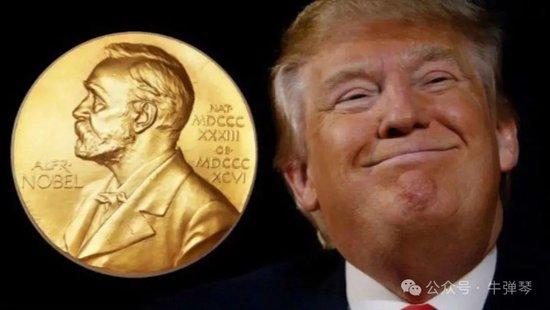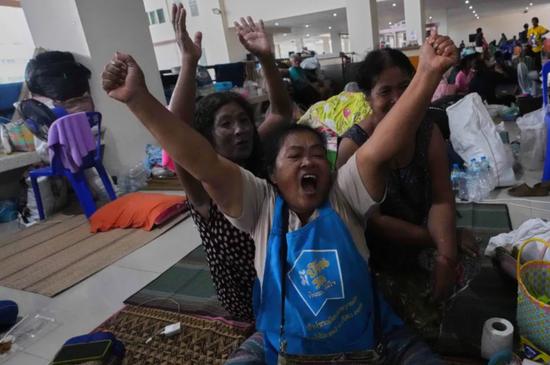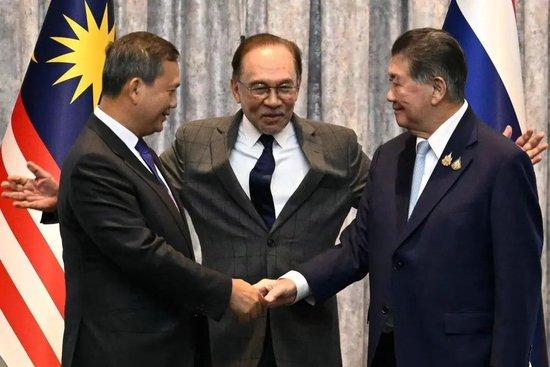


Frankly speaking, the ultimate ceasefire in Thailand and Cambodia hinges on a single photo.
This is a particularly special picture, linked to the United States, China, and Malaysia.
It’s undeniable that during this peace mediation, Malaysian Prime Minister Anwar, serving as the ASEAN Chair, has played a pivotal role.
The picture captures Anwar seated at the chairman’s position, flanked by two distinguished guests: the Thai Deputy Prime Minister Phatakorn and the Cambodian Prime Minister Hun Sen.
However, it’s worth noting that behind Anwar, there are two tables, each occupied by a significant guest.
According to media reports, one guest is an American official, while the other is a Chinese official.
With both countries stepping in simultaneously, Malaysia acting as the mediator, the leaders of Thailand and Cambodia engaged in face-to-face negotiations.
Cambodia and Thailand have reached a consensus: from midnight on July 28, 2025 local time, they will immediately implement a unilateral ceasefire.
“This is a crucial first step,” Anwar added, stating that both leaders “have expressed their positions and are willing to immediately cease fire, ease tensions, and restore peace and security.”
In front of the camera, Anwar was also holding hands with Phatakorn and Hun Sen, all smiling and placing their hands together.
This represents the ASEAN version of a smile that melts enmities.
Two hours later, the Thai military reported that the border battle had ended.
As for Cambodia, CNN quoted eyewitnesses saying that explosions were no longer heard.
A border conflict that resulted in dozens of deaths and hundreds of thousands fleeing, marking the most severe in over a decade, finally came to an end.
I always feel that this was a classic international mediation effort, and it could potentially serve as a model for future international mediation efforts.
First and foremost, ASEAN still has its high-level players.
This time, it was Malaysian Prime Minister Anwar who stepped up.
Interestingly, among ASEAN countries, Cambodia and Thailand are two Buddhist-believing nations; Malaysia is predominantly an Islamic country.
However, this does not hinder Anwar immediately calling for peace and leveraging his role as the ASEAN Chairperson to invite leaders from Thailand and Cambodia to visit.
It’s particularly noteworthy that after Trump announced a ceasefire in Thailand and Cambodia, the actual conflict between the two countries continued fiercely.
During negotiations in Kuala Lumpur, Anwar spoke of various noble causes in the ASEAN way, ultimately facilitating this peace.
Secondly, we cannot overlook the role of the United States.
Thailand and Cambodia finally reached a ceasefire, and Trump, who was also in Scotland, was pleased.
With President Trump’s participation, the two countries have reached a ceasefire and peace. Congratulations to everyone! Ending this war has saved thousands of lives. I have instructed my trade team to restart trade negotiations. In just six months, I have concluded multiple wars—I am proud to be the president of peace!
This is a typical Trumpian statement.
The conflict was intense, but it seems far from reaching thousands of people, yet it did not prevent Trump from self-promoting and loudly proclaiming: I can become the president of peace.
As I mentioned before, Trump has always been eager to win the Nobel Peace Prize. Obama could get it, but Trump hasn’t, which he has been grievously upset about.
More importantly, Trump has dual natures, which…
On one hand, we should strategically confront Trump’s mistakes; on the other hand, we must also strive to inspire positive energy in Trump—negotiating peace matters, Trump, you still need to do more.
Thirdly, we must recognize the positive role China plays.
Why were Chinese officials present at the photo?
Because China’s weight, its stance, and its influence are all there.
Thailand and Cambodia lack trust in each other; when the US is present, and China is too, it helps resolve the issue more effectively.
In fact, regarding the conflict between Thailand and Cambodia, no other major country is as eager for a peaceful resolution as China.
On July 28th, at the Ministry of Foreign Affairs meeting, I noticed that Reuters asked a question:
The acting Prime Minister of Thailand stated on Monday (28th) that China had proactively offered assistance in resolving the conflict between Thailand and Cambodia. Could China confirm this? Could you provide details about the proposal made by China?
Cambodia and Thailand are inseparable neighbors, both being friendly countries under China’s patronage. China deeply sympathizes with the casualties caused to the people of Cambodia and Thailand due to the conflict and extends sincere condolences… In recent days, ASEAN has actively promoted ceasefire efforts between Cambodia and Thailand. China appreciates these efforts and welcomes any efforts that contribute to de-escalation. China will uphold a fair and impartial stance, continue close communication with Cambodia and Thailand, actively promote peace talks, and play a constructive role in bringing an end to the conflict.
This is what we see; on one hand, China fully supports ASEAN and Malaysia in promoting a ceasefire; on the other hand, it is more active in communicating closely with Cambodia and Thailand, encouraging peace talks.
Unlike the United States, which is not as brash, China has not been absent but has indeed played a significant role.
I have seen statements from both Puttan and Hong Ma Nai expressing gratitude towards the mediation efforts between China and the US.
Firstly, cooperation between China and the US can achieve a lot.
Many seemingly insurmountable issues can be resolved if China and the US work together and make efforts.
When ASEAN steps in and the US is present, isn’t it like the conflict between Thailand and Cambodia just quietly subsiding?
This approach could become a model for future international conflict resolution.
Secondly, Cambodia and Thailand face significant developmental tasks.
It’s truly heartbreaking to see such good neighbors fighting over petty matters.
Let’s not dwell on the past grievances; otherwise, it’s like June rain turning old sheep into ice—it’s too long to talk about.
We must recognize that developmental tasks are very heavy, especially for Cambodia.
The two countries must cherish the opportunity for peace, and if war breaks out again, it will undoubtedly be the most unfortunate among the lowest-ranking citizens.
Thirdly, Trump is bound to have another thing to say.
As mentioned earlier, he immediately issued a statement, openly stating how he would handle the situation with Trump’s involvement.
It was truly without any modesty at all.
White House Press Secretary LaVelle E. Smith, who understood perfectly, immediately tweeted in response:
President Trump has made this ceasefire a reality. He deserves the Nobel Peace Prize!
It seems that if the Nobel Peace Prize isn’t awarded to him this year, Trump could easily topple the roof of the Norwegian Parliament.
However, what’s interesting is that later, when meeting with British Prime Minister Sturgeon in front of the cameras, Trump boasted,
If it weren’t for him, there would have been at least six major wars going on…
Trump cited India-Pakistan conflicts and Congo (Kinshasa)… but when talking about the latest Thai-Cambodian conflict, he surprisingly didn’t mention the names of the countries, only repeatedly saying “these two countries.”
Some netizens speculated whether Trump might have forgotten the names of these two countries.